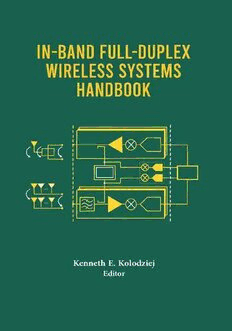
In-Band Full-Duplex Wireless Systems Handbook PDF
Preview In-Band Full-Duplex Wireless Systems Handbook
In-Band Full-Duplex Wireless Systems Handbook For a listing of recent titles in the Artech House Mobile Communications Series, turn to the back of this book. In-Band Full-Duplex Wireless Systems Handbook Kenneth E. Kolodziej Editor Library of Congress Cataloging-in-Publication Data A catalog record for this book is available from the U.S. Library of Congress. British Library Cataloguing in Publication Data A catalog record for this book is available from the British Library. ISBN-13: 978-1-63081-789-3 Cover design by Kalyani Kastor © 2021 Artech House 685 Canton Street Norwood, MA 02062 All rights reserved. Printed and bound in the United States of America. No part of this book may be reproduced or utilized in any form or by any means, elec- tronic or mechanical, including photocopying, recording, or by any information storage and retrieval system, without permission in writing from the publisher. All terms mentioned in this book that are known to be trademarks or service marks have been appropriately capitalized. Artech House cannot attest to the accuracy of this information. Use of a term in this book should not be regarded as affecting the validity of any trademark or service mark. 10 9 8 7 6 5 4 3 2 1 To my wife, Maria-Christina, for encouraging and supporting me since the day I met her, and to my daughter, Briana, for making me smile and helping me realize that being a dad is my true calling in life. Vi amo tantissimo! Contents Foreword xv Preface xvii CHAPTER 1 In-Band Full-Duplex Overview 1 1.1 Introduction 1 1.2 System Overview 2 1.2.1 Transceiver Diagram 2 1.2.2 Self-Interference Cancellation Techniques 4 1.3 Literature Review 5 1.3.1 Publications 5 1.3.2 System Survey 6 1.4 Book Organization 10 1.5 Practical Considerations 12 1.6 Conclusion 13 1.6.1 Summary 13 1.6.2 Future Directions 13 References 14 CHAPTER 2 Antenna Subsystems 17 2.1 Introduction 17 2.2 Bistatic Antenna Subsystems 19 2.2.1 Introduction 19 2.2.2 Decoupling Techniques 19 2.2.3 Merits and Challenges 22 2.3 Monostatic Antenna Subsystems 23 2.3.1 Introduction 23 2.3.2 Antiphase Spiral 24 2.3.3 Sequentially Rotated Array Antennas 25 2.3.4 Circular Arrays 25 2.3.5 Balanced Feed Networks 28 2.3.6 Performance Comparison 30 vii viii Contents 2.4 Quasi-Monostatic Antenna Subsystems 31 2.4.1 Introduction 31 2.4.2 Single Reflector 31 2.4.3 Dual Reflector 33 2.5 Hybrid Antenna Subsystems 33 2.6 Practical Considerations 37 2.7 Conclusion 37 2.7.1 Summary 37 2.7.2 Future Directions 37 References 38 CHAPTER 3 Electrical Balance Duplexers 41 3.1 Introduction 41 3.2 Principles of Operation 42 3.2.1 Pre-Electronic Telephone 42 3.2.2 Tx-Rx Isolation 44 3.2.3 Tx and Rx Insertion Losses 46 3.3 Balancing Networks 47 3.3.1 Wideband Balancing 47 3.3.2 Passive Balancing Networks 47 3.3.3 Active Balancing Networks 48 3.3.4 Prototype and Measurement Results 50 3.4 Dynamic Adaptation 51 3.4.1 Environmental Interaction 51 3.4.2 Dynamic Simulations 52 3.4.3 Real-Time Adaptive Implementation 53 3.4.4 Measurement Environments 54 3.4.5 Results 54 3.5 Practical Considerations 55 3.6 Conclusion 56 3.6.1 Summary 56 3.6.2 Future Directions 56 References 57 CHAPTER 4 Nonmagnetic Circulators 59 4.1 Introduction 59 4.2 Nonmagnetic Nonreciprocal Circulators Based on Permittivity Modulation 62 4.2.1 Circulators Based on Parametric Modulation 63 4.2.2 Circulators Based on Angular Momentum Biasing 64 4.3 Nonmagnetic Nonreciprocal Circulators Based on Conductivity Modulation 65 4.3.1 Switched-Capacitor-Based Structures 65 4.3.2 Switched-Delay Structures 67 Contents ix 4.4 Practical Considerations 69 4.5 Conclusion 70 4.5.1 Summary 70 4.5.2 Future Directions 70 References 71 CHAPTER 5 Photonic-Based Antenna Interfaces 73 5.1 Introduction 73 5.2 Analog Photonic Front-End Cancellation Techniques 75 5.2.1 Counterpropagating Cancellation 75 5.2.2 Subtraction Cancellation 84 5.3 Practical Considerations 88 5.4 Conclusion 89 5.4.1 Summary 89 5.4.2 Future Directions 89 References 89 CHAPTER 6 Code-Based RF Filtering 91 6.1 Introduction 91 6.2 Code-Domain Principle 91 6.3 System-Level Discussion 93 6.3.1 Spectral Efficiency 93 6.3.2 Code-Domain Codes 94 6.3.3 Jammer and Noise Tolerance 97 6.3.4 Multipath Tolerance 98 6.4 CMOS Techniques for RF Code-Domain Rx Front Ends 99 6.4.1 Modulating N-Path Filters with Pseudorandom Noise Codes 99 6.4.2 Code-Selective Bandpass Filters 100 6.4.3 Code-Selective Notch Filters 100 6.4.4 Low-Noise Amplifier with Code-Selective Feedback 103 6.5 CMOS Techniques for Tx Code-Domain Modulation and Spectral Shaping 104 6.5.1 High-Power, High-Modulation Bandwidth CMOS Switch Design 104 6.5.2 Spectral Shaping Approaches 107 6.6 Practical Considerations 109 6.7 Conclusion 110 6.7.1 Summary 110 6.7.2 Future Directions 111 References 111 CHAPTER 7 Photonic-Based RF Filtering 113 7.1 Introduction 113
